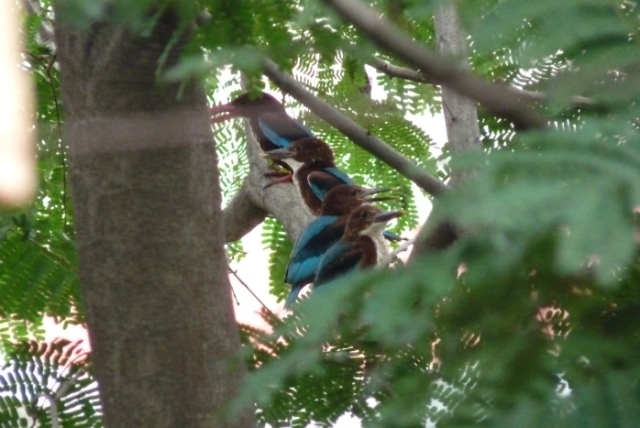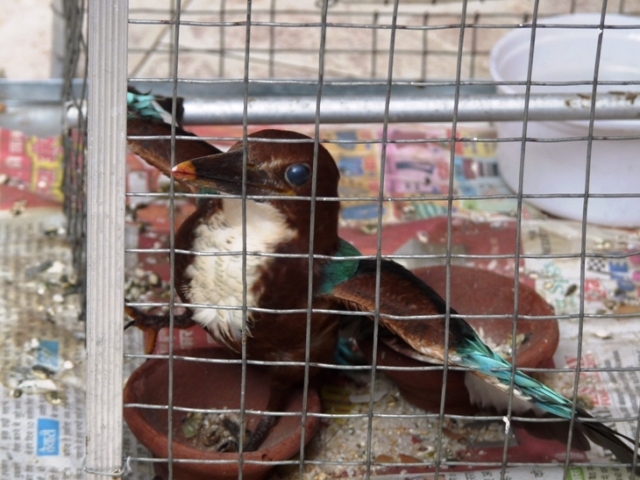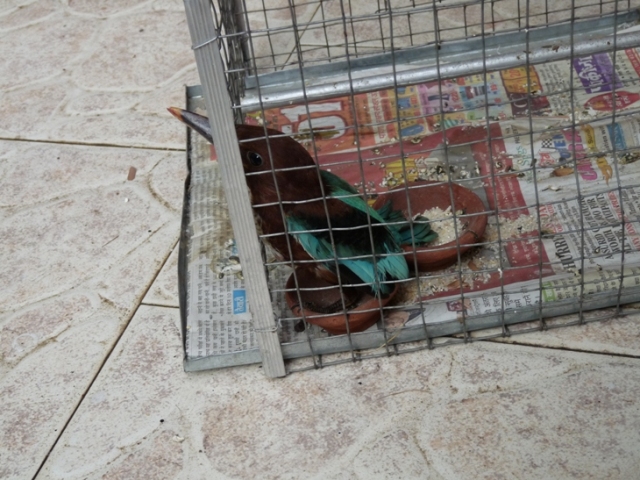Miraculous escape of the kingfisher chick
-Ajay Gadikar
Love to share a story of the miraculous escape of a white throated kingfisher (Halcoyn smyrnensis) chick.
A solitary White Throated Kingfisher has been living on a tree in front of my house since many years. It comes to roost on the tree every evening at dusk and then every day, at dawn it flies away to its nearby feeding grounds.
The white throated kingfisher
Every morning, before leaving its perching point, it makes a loud sound and flies off swiftly to sit on a nearby electric pole. This morning routine of his coincided with my wake up time, so many a time, I used to watch him moving
out for foraging in search of food.
When it comes to roost in the evening, on his favourite perch, it usually lands, first, onto an electrical wire, right in front of my house, then it flies off to the tree, and there, it slowly and steadily moves to its fixed and favourite perch making
a typical low call.
The white throated kingfisher has a very prominent beak, adapted to catch fish. This is similar to other kingfishers, but it has adapted well and is able to survive on various other vertebrates found in the city. It feeds on lizards, mice, frogs, dragonflies,
grasshoppers, small perching birds found in the urban areas.
One fine Sunday afternoon, my wife told me that she had seen 3 or 4 kingfishers on that very tree. I was very curious to see them and went into my balcony to confirm this bit of exciting information. I grabbed my binoculars to get a close view and ascertain
that they were all, indeed king fishers. Of so many birds on the tree, from our balcony, they could be seen clearly; I find that one of them was an adult bird and the rest of the three were juveniles. I was amused to see that all the four birds were sitting
in a row on one of the branches.

The Kingfisher family
I could not spot the area where the kingfisher had made his nest. Usually the kingfisher nests in long, horizontal crevices and holes. Their nests are very distinctive and are found near river banks or streams. Their nests are holes dug into the eroded
embankments along the river and are about 3 inches in diameter and are often 1 to 3 feet in length.
In this case the adult female would have laid eggs at some suitable place nearby. After the chicks are fledged, the parents would have guided them to come on this tree, as they must have felt it was a safer place for their fledglings. The fledglings must
be around in the safe company of parents for few more days before being let out on their own.
We enjoyed watching the adults feeding the juveniles and took some photographs. After an hour or so, my son saw one of the chicks lying on the ground and making low calls. We immediately rushed to help the chick. We found that it was not able to fly and
seemed to be weak. Maybe this chick was not properly fed and hence being weak, fell down from the tree. As rescuing a chick is not an easy task, we first carefully put it inside a cage (borrowed from a neighbour) so that the chick can be safe and out of reach
of the cat and dog of the township. We then put in some water and tried to feed it some fruit.

The exhausted chick
But the chick was not eating anything. I recalled that on an earlier occasion, while rescuing a hornbill chick, we had the same problem of not knowing the bird’s diet and now again we were facing a similar situation. Then we brought some insects for it,
but we understand that he had to be given the food in a specific manner, and only then could it eat. Finally, at the end of the day we decided to leave it on the roof in the morning and hoped that its parents would come and feed it and it would survive.

The kingfisher chick
We waited anxiously till the next morning and were happy to find the chick in a good condition. We saw the adult birds were feeding their other young ones on the same tree, so we decided to free the chick and see what happens next, to our delight the chick
slowly moved forward and sat on the wall, making continuous calls. Within few minutes, we saw the adult bird bringing a small insect in its mouth and feeding it. We felt very happy for the fledgling. For another hour or two we watched the chick. It was eating
continuously and that made it look better and so it was able to hop around.
We then went about our work like every day. In the evening, we checked with our neighbours if they had seen any casualty around and thankfully there was none. We happily assumed that the chick would have gained strength and must be safely roosting on the
tree and our attempt to save the chick was accomplished.
Thanks.
Ajay Gadikar is a bird watcher and naturalist from Indore.